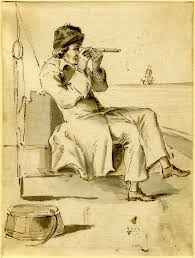Monday, August 13th
Course Introduction
Wednesday, August 15th
Introduction to the Eighteenth Century (xxxiii-lxix)
John Locke, “Of Ideas” from An Essay Concerning Human Understanding, 1689 (BABL 18th-C: 159-160)
Isaac Newton, Letter to Richard Bentley, 10 December 1692 (BABL 18th-C: 177-179)
James Thomson, excerpted stanzas from “A Poem Sacred to the Memory of Sir Isaac Newton,” 1727 (BABL 18th-C: 179-180)
Mark Akenside, “Hymn to Science,” 1739 (BABL 18th-C: 180-181)
Glossary terms discussed in class: ode, hymn, stanza, blank verse. Other terms discussed in class today: parallelism, zeugma, anaphora
In-Class Writing: In about one paragraph discuss an aspect of eighteenth-century English history/culture/science that you read about in the prose reading (i.e. the Broadview Introduction, Locke and/or Newton) and connect it to one of the poems that you also read. In your response, support your assertions by quoting specifically from the prose and poem(s). After you cite your evidence, provide one sentence describing how your textual evidence supports your argument.
**
Daniel Defoe, Moll Flanders, 1722,(Preface 39-43, pages 45-150, to “. . . at least not in London”)
Glossary: I recommend that you read the novel first and then read the following passages from the Glossary: novel (with particular attention to those subgenres you find to be applicable to Moll Flanders; point-of-view (with particular attention to first-person points of view). If you haven’t studied the novel in the past, it will also be helpful for you to read the entry on plot.
We’ll also discuss the two poems you read for Wednesday; you don’t need to bring your anthology with you unless you would like to.
Link to Thomson’s “A Poem Sacred to the Memory of Sir Isaac Newton”
Link to Akenside’s “Hymn to Science”
Group Work: What are your expectations when you read a novel? In what ways did the first 150 pages of Moll Flanders conform or disrupt those expectations?
What connections did you make to our reading from last week?
Wednesday, August 22nd
Defoe, Moll Flanders (pages 150-205, to “. . . and seek for what might happen)
Joseph Addison, The Spectator, No. 69, 19 May 1711 (BABL 18th-C: 914-916)
Daniel Defoe, “Of the Dignity of Trade in England More than in Other Countries, 1726 (BABL 18th-C: 916-917)
Terms discussed in class:
Definition of the Novel (OED (Oxford English Dictionary) accessed through libs.uga.edu, then the database)
See “Novel” entry in Glossary, Abrams, et. all, with particular attention to descriptions of the picaresque, the novel of incident, and the novel of character. Important to understand the difference between the novel and the prose romance and gothic romance (See Abrams, et. al. entry). Definitions of the “realistic novel” and the “bildungsroman” are also interesting here but cannot really be applied to Moll Flanders.
**
Monday, August 27th
Finish Moll Flanders
Johnson, from The Rambler, No. 4, 31 March 1750, [On Fiction] (BABL 18th-C: 766-769)
In-Class Writing: Does Moll Flanders fulfill Samuel Johnson’s definition of ideal fiction as described in 1750? If so, how? If not, how? Please support your evidence with specific evidence from both texts. You should use at least one direct quote in your response but should feel free to paraphrase as well.
Wednesday, August 29th
Pope, from An Essay on Man, including “The Design” and Epistle 1, 1733, (BABL 18th-C: 575-579) <Outline of An Essay on Man>
Samuel Johnson, The Vanity of Human Wishes: The Tenth Satire of Juvenal Imitated, 1783, (BABL 18thC: 759-765) <Outline of The Vanity of Human Wishes>
Glossary: Enlightenment; Essay; The Great Chain of Being; antithesis; apostrophe; rhetorical questions, alliteration; heroic couplet and other Rhetorical Figures: zeugma, chiasmus, parallelism, anaphora (click on link for definitions and examples);
Another definition of anaphora: “A rhetorical device involving the repetition of a word or group of words in successive clauses” (from The Penguin Dictionary of Literary Terms and Literary Theory, 4th edition 37)
In-Class Writing:
What did you notice about how these poems were written? Please give an example of a particularly notable line, couplet, or image.
Did you notice a difference in how these two writers used the heroic couplet? How can you distinguish between the two poems?
Link to September’s Schedule
Link to Course Homepage


